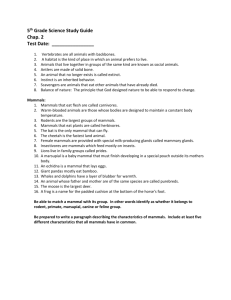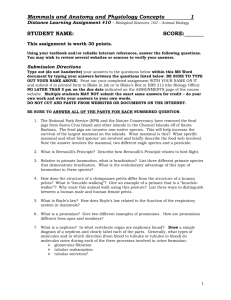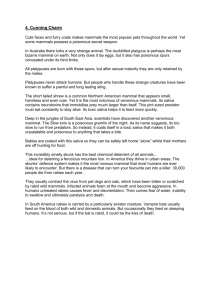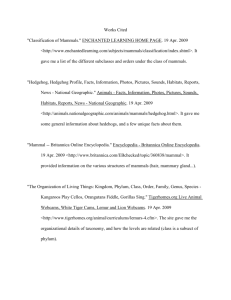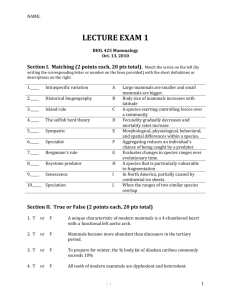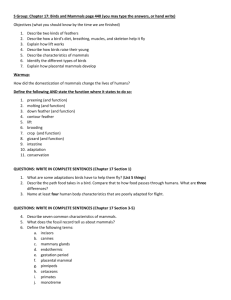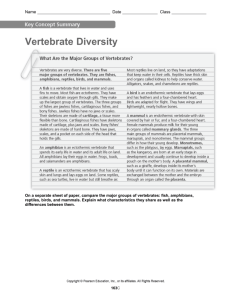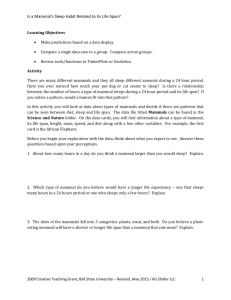FUN FACTS ABOUT MAMMALS SIZE Small: What`s the smallest
advertisement
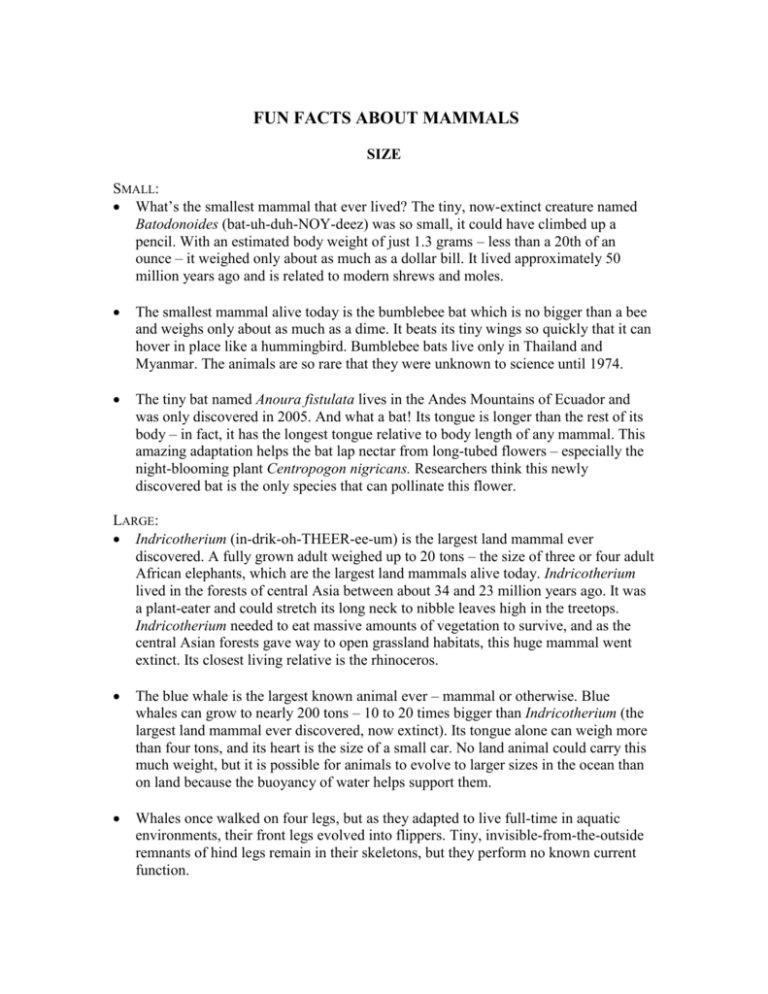
FUN FACTS ABOUT MAMMALS SIZE SMALL: What’s the smallest mammal that ever lived? The tiny, now-extinct creature named Batodonoides (bat-uh-duh-NOY-deez) was so small, it could have climbed up a pencil. With an estimated body weight of just 1.3 grams – less than a 20th of an ounce – it weighed only about as much as a dollar bill. It lived approximately 50 million years ago and is related to modern shrews and moles. The smallest mammal alive today is the bumblebee bat which is no bigger than a bee and weighs only about as much as a dime. It beats its tiny wings so quickly that it can hover in place like a hummingbird. Bumblebee bats live only in Thailand and Myanmar. The animals are so rare that they were unknown to science until 1974. The tiny bat named Anoura fistulata lives in the Andes Mountains of Ecuador and was only discovered in 2005. And what a bat! Its tongue is longer than the rest of its body – in fact, it has the longest tongue relative to body length of any mammal. This amazing adaptation helps the bat lap nectar from long-tubed flowers – especially the night-blooming plant Centropogon nigricans. Researchers think this newly discovered bat is the only species that can pollinate this flower. LARGE: Indricotherium (in-drik-oh-THEER-ee-um) is the largest land mammal ever discovered. A fully grown adult weighed up to 20 tons – the size of three or four adult African elephants, which are the largest land mammals alive today. Indricotherium lived in the forests of central Asia between about 34 and 23 million years ago. It was a plant-eater and could stretch its long neck to nibble leaves high in the treetops. Indricotherium needed to eat massive amounts of vegetation to survive, and as the central Asian forests gave way to open grassland habitats, this huge mammal went extinct. Its closest living relative is the rhinoceros. The blue whale is the largest known animal ever – mammal or otherwise. Blue whales can grow to nearly 200 tons – 10 to 20 times bigger than Indricotherium (the largest land mammal ever discovered, now extinct). Its tongue alone can weigh more than four tons, and its heart is the size of a small car. No land animal could carry this much weight, but it is possible for animals to evolve to larger sizes in the ocean than on land because the buoyancy of water helps support them. Whales once walked on four legs, but as they adapted to live full-time in aquatic environments, their front legs evolved into flippers. Tiny, invisible-from-the-outside remnants of hind legs remain in their skeletons, but they perform no known current function. ANATOMY, ADAPTATIONS, AND EVOLUTION All mammals – and only mammals – have three bones inside their middle ear. It’s one of the ways scientists recognize a mammal, even when they’ve got nothing but a fossil skull. Over millions of years of evolution, some jaw bones moved inside the ear, leaving mammals with a single jaw bone. What might seem like the most normal thing in the world to us – walking upright on two legs – is actually one of humankind’s most extreme features. The only other mammals that travel primarily on two legs don’t walk, but hop, like kangaroos. Walking like humans is rarer among mammals than laying eggs. Mammal extinctions are happening rapidly today: during the past 500 years, at least 75 mammal species are known to have died out, with many more barely hanging on. Today, nearly 25 percent of living mammal species are threatened with extinction. One of the oddest-looking mammals that ever lived is the extinct South American ungulate Macrauchenia. Along with a camel-like body and a giraffe-like neck, it had one of the most extreme of noses: a long, flexible trunk, something like an elephant’s. Macrauchenia (Mack-raow-KEEN-ee-a) went extinct only around 10,000 years ago. Unlike other mammals, monotremes, like the platypus, never evolved live birth, but instead lay eggs. Monotremes produce milk for their young but lack nipples, so their milk just oozes out of mammary gland ducts and collects in grooves on patches of skin, where the nursing babies lap it up or suck it from tufts of fur. A mother kangaroo can actually have three babies at the same time, all in different stages of development. Even with two nursing joeys, a red kangaroo might have an extra fertilized egg in her belly, in suspension. This egg doesn’t begin to grow until one of the older offspring stops nursing. ANATOMY, ADAPTATIONS, AND EVOLUTION: HEADS! HEADGEAR: Ossicones are bony cores that develop first as knobs of cartilage covered by skin. A baby giraffe’s ossicones lie flat against the head at birth and pop upright about a week later. The knob later becomes bone. Ossicones are usually covered with skin and fur. Antlers – a pair of branched bones that are shed annually – a row each year from a permanent bony, skin-covered base. Antlers grow very quickly, up to an inch a day. The male babirusa, a pig from Indonesia, has teeth that protrude from the top of its snout, used for fighting. The babirusa’s upper canines don’t grow downward as normal ones would, but directly upward, through the top of the skull bone and out through the muzzle skin. It’s pretty hard to imagine a mouse with bony headgear. But a genus of extinct rodents really did have horns, including the foot-long Ceratogaulus rhinoceros. These relatives of the living mountain beaver might have used their horns to woo mates or to protect themselves from predators. TEETH: Like living elephants, extinct mammoths had six sets of grinding teeth during their lifetimes, each one larger than the last. The largest molar could weigh four pounds. These ridged teeth helped the animals chew tough grasses, shrubs, and twigs. BRAIN: Despite having the largest absolute brain weight of any animal – up to 20 pounds – sperm whales have small brains for their body size of up to 110,000 pounds. Aye-ayes have much larger brains than their closest primate relatives, other lemurs, possibly to allow for their complex food-hunting strategies. With their two wiry, very long middle fingers, aye-ayes patiently tap tree branches and listen to the pitch of the taps to locate the bugs inside. Then, with their skinny, flexible middle digits, they pull out the catch. EYE: When aye-ayes bore through branches with their sharp front teeth, sawdust can fly. Luckily, their eyes have built-in third eyelids – almost like goggles – that moisten the eyes and protect them as they work. A tiny nocturnal primate, the tarsier has eyeballs that bulge too tightly against the skull to pivot. To see around itself, a tarsier must swivel its entire head, which can rotate nearly 180 degrees in each direction. To learn more about the surprising and sometimes bizarre world of extinct and living mammals, visit the special exhibition Extreme Mammals at The Field Museum, May 26 through Jan. 6, 2013. For more information, visit fieldmuseum.org. # # #
